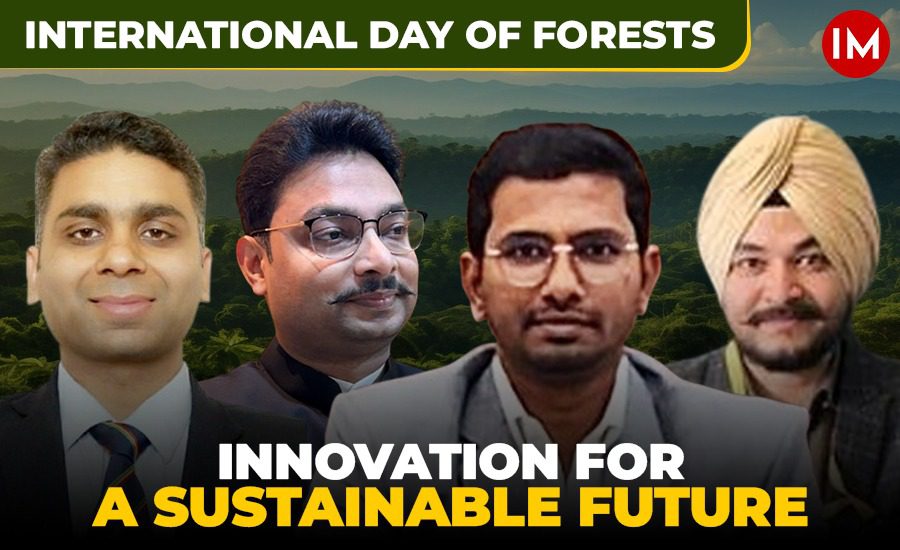Today is International Day of Forests, a day dedicated to celebrating the importance of these irreplaceable ecosystems and raising awareness about the threats they face. This year’s theme, “Forests and Innovation: New Solutions for a Better World,” underscores the crucial role technology can play in protecting our forests. In line with this theme, Indian Masterminds spoke to forest officers on the cutting edge of innovation.
Q- What are the possibilities for utilizing innovative wood products and bio-materials as sustainable alternatives to conventional materials like steel and concrete in India’s construction sector?
2018-batch IFS officer Vineet Kumar, who is posted as DFO, Anantapur, shared, “The possibilities are unbound for utilizing sustainable materials for construction. In fact, new sustainable, innovative materials are the future. This is because of three main factors.”

- These materials are environment-friendly and cannot be compromised to protect the environment, as our survival is linked to the health of the environment and Mother Earth.
- These innovative materials are multipurpose, meaning the same material can be used for interiors, outdoors, construction, structural, etc. Many such materials, such as engineered wood, are available on the market that are less harmful to the environment and are produced from organic materials.
- The field of design is going through a shift, and customers want to have unique ideas for home decor, interiors, crafts, etc. where these sustainable materials, with their properties, can be used by designers to customize unique sets of experiences. Major firms are focusing on such materials.
Another gap to be filled by the use of such materials is the availability of skilled labor who can work on these sustainable alternatives. Traditional artisans like carpenters and painters can be skilled with these new materials to ensure the trust of customers in the skills of workers as well as the easy implementation of such innovative solutions to the last mile. Private farmhouses, eco-tourism centers, resorts, public housing projects, etc. can all use such innovative materials, which are not only sustainable but also less permanent in nature, leaving a smaller footprint and being easier to install once the prototypes are finalized. A lot of research in material science is focused on producing the materials of the future that are not only sustainable but also mass-produced, low-cost, and promote the concepts of circular economy, leading to fewer wastes.
“We have used such materials, though on a small scale, for building the cottages at the eco-tourism center run by the Forest Department at Pacherla in the Nandyal district of Andhra Pradesh,” Mr. Kumar shared.
Q- How can we encourage innovation in non-timber forest products (NTFPs) to create new income opportunities for forest-dependent communities while ensuring sustainable harvesting practices?
2018-batch IFS officer Vejayanantham TR, DFO, South Betul Forest Division, shared, “We need PPP mode in collection, processing, and marketing. The private sector has the best technologies, quality assurance systems, and marketing strategies. The government has the last mile reach and faith of the people. We have to bring both together. Using export standards in collection and processing, organic certification of NTFPs is the need of the hour.”

Q- In your opinion, what innovative solutions hold the most promise for ensuring the future health and productivity of Indian forests?
“The Forest Department lacks real-time data. Whether it is forest management or human resource management, we need to create systems like control rooms and command centers to monitor forest protection works, patrolling, and the activeness of the barriers in real-time. It’s better to protect what we have than to create a new one, as it takes hundreds of years for the forest ecosystem to develop,” Mr. Vejayanantham said.
Q- How can AI, drones, and satellite technology be better utilized for forest fire prevention, detection, and management in India?
2014-batch IFS officer Yashu Deep Singh, who is currently on central deputation at Chandigarh within the Ministry of External Affairs, Government of India, said, “I believe that there is huge potential in the use of AI for forest fire detection.” Currently, it relies on satellite imagery and the census data used by the satellites. He further said that by analyzing past years’ data, AI can predict the most prone areas and detect various parameters indicating changing atmospheric conditions and village activities.

This will enable the department to anticipate and identify days when forest fires are more likely to occur and in which locations. “I think it is entirely feasible, and such tools could be immensely beneficial in protecting and preventing forest fires, focusing more on prevention rather than fire control.”
2019-batch IFS officer Ankit Kumar, who is posted as Deputy CEO, CAMPA, and DCF, Industries, Arunachal Pradesh, shared that there are not many fire hotspots in Arunachal Pradesh, but the use of technology is crucial wherever needed. For fire hotspot detection, they utilize GIS media and an application through which people can share information about forest fires. GIS media is used for people’s participation.

“I’m not sure how useful AI will be in this regard, but if early detection can be achieved, it could prove beneficial, for which we require better technology. AI could assist in collating data and providing advance alerts,” the officer said.
In the North East area, drone usage is minimal due to the dense canopy, making it difficult to navigate drones within the forest. Manual deployment of forest guards is most effective.

































